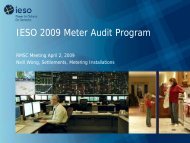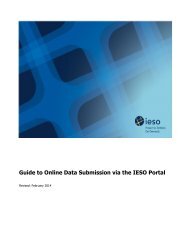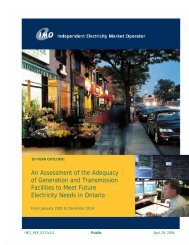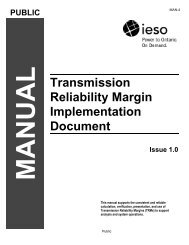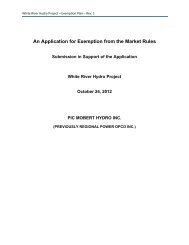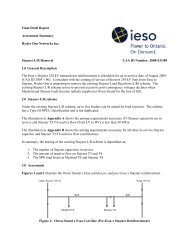Participant Technical Reference Manual - IESO
Participant Technical Reference Manual - IESO
Participant Technical Reference Manual - IESO
Create successful ePaper yourself
Turn your PDF publications into a flip-book with our unique Google optimized e-Paper software.
4. Operational Metering Equipment & AGC IMO_MAN_0024<br />
The market participant may be required to demonstrate that the electrical power<br />
supplies meet the requirements. Also, the market participant may be required to<br />
demonstrate that the environment in which the RTU and telecommunications<br />
equipment is installed meets the manufacturer‟s environmental requirements.<br />
294 A telecommunication connection must be established between the market<br />
participant and <strong>IESO</strong>. Market participants will grant access to their premises to<br />
<strong>IESO</strong> staff or <strong>IESO</strong> designated staff to establish the required telecommunication<br />
connection.<br />
295 The work involved in establishing this connection typically includes:<br />
a. installation of a local loop between the RTU location and a telecommunications service<br />
provider;<br />
b. installation of telecommunication equipment at the market participant’s premises. Typically<br />
this equipment is comprised of three small modules, the Frame Relay Access Device<br />
(FRAD), the Digital Service Unit (DSU) and the dial-up modem; and<br />
c. verifying that the telecommunication connection is working properly.<br />
296 RTU Check-In Service is the final step in RTU Site Certification. This involves<br />
the verification of the accuracy of the RTUs database to ensure a proper<br />
correspondence between the actual field device such as a breaker or<br />
measurement and the representation in the RTU. The proper operation of the<br />
RTU with <strong>IESO</strong>‟s Energy Management System (EMS) and the verification of<br />
the RTU database being transmitted to the <strong>IESO</strong> will also be verified. Details of<br />
the check-in-service process are available from the <strong>IESO</strong>.<br />
4.2 AGC Operational RTU Specifications<br />
297 Automatic generation control (AGC) is a contracted ancillary service used by<br />
the <strong>IESO</strong> to fine-tune the match between generation and load. Specific details<br />
of implementation will be determined during the contracting process.<br />
298 The actual control of generators under AGC is accomplished by control signals<br />
sent directly by the <strong>IESO</strong> to the plant controller or RTU installed for data<br />
gathering and control. The <strong>IESO</strong> can send either pulse commands to raise or<br />
lower generation or it can send MW setpoint commands to change the<br />
current generation. The type of signal the sent to a specific unit that is<br />
providing AGC is determined by the <strong>IESO</strong> and is also dependent on the<br />
design of the unit’s governor system which controls the power input to the<br />
generator. A number of associated data inputs, such as generator status,<br />
generator output, etc. must also be telemetered by the RTU to the <strong>IESO</strong> Control<br />
Center.<br />
299 The control signals from the plant controller or RTU will issue raise/lower<br />
pulses using an output relay. These can be dry or wet contacts depending on the<br />
configuration. The pulses typically are one second in length. On receipt of a<br />
raise/lower pulse, the generating units under AGC control are expected to<br />
change their output MW by a pre-determined amount.<br />
300 Units which do not have remote MW setpoint capability in their governors will<br />
execute a power change based on the pulse width (time that the pulse is active)<br />
of the raise or lower pulse provided by the <strong>IESO</strong>’s AGC controller. The pulse<br />
74 Public Issue 21.1 – March 15, 2010 - estimated






